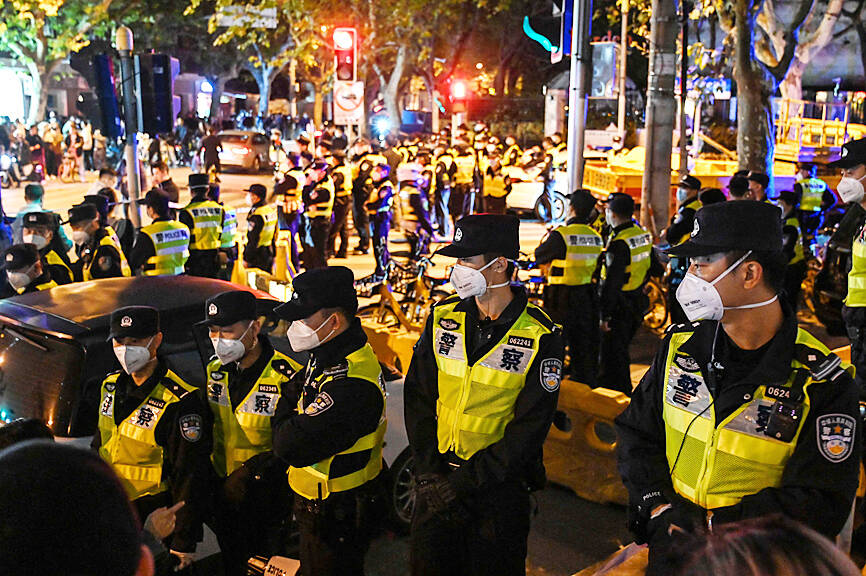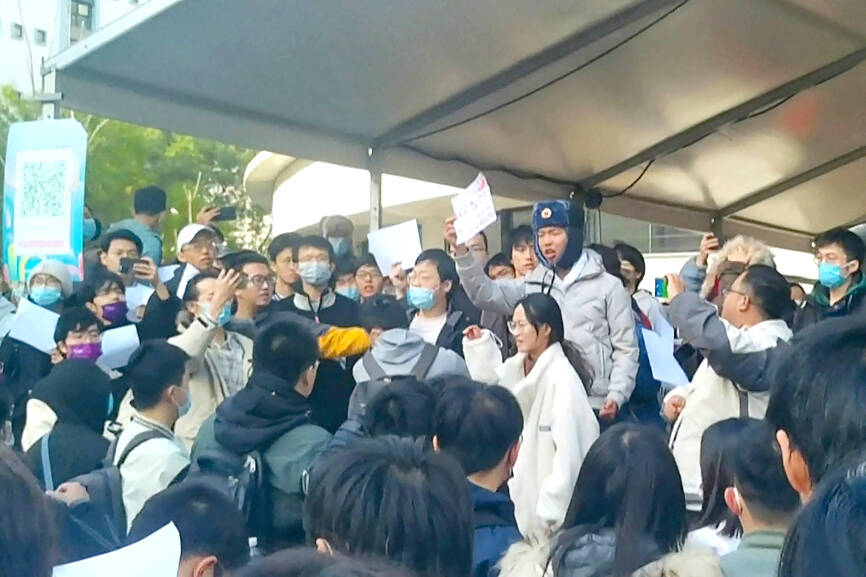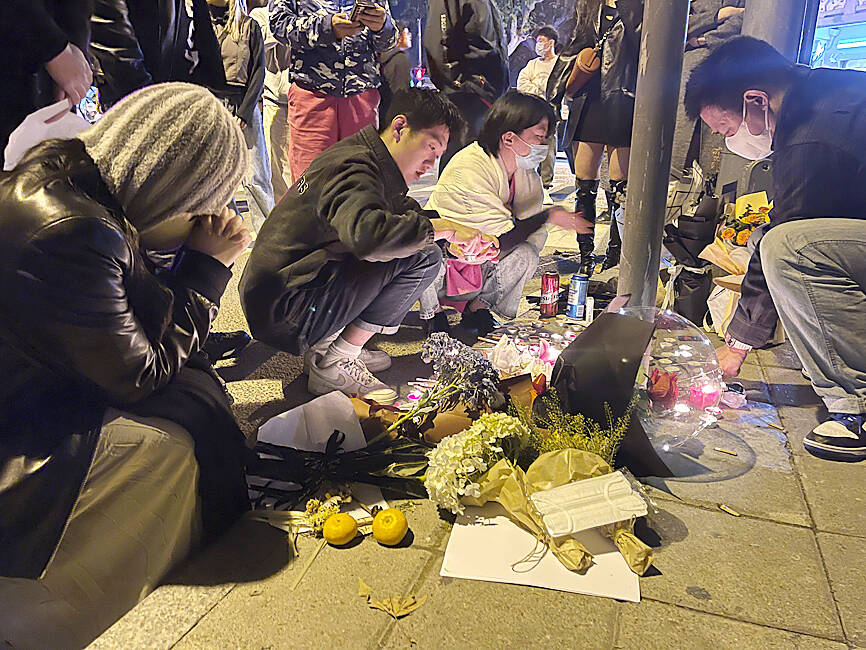Hundreds of people yesterday took to the streets in Beijing and Shanghai to protest China’s “zero COVID” policy in a rare outpouring of public anger against the state.
China’s hardline disease prevention strategy is stoking public frustration, with many growing weary of snap lockdowns, lengthy quarantines and mass testing campaigns.
A deadly fire on Thursday in Urumqi, the capital of China’s Xinjiang region, has become a fresh catalyst for anger, with many blaming lengthy COVID-19 lockdowns for hampering rescue efforts.

Photo: AFP
Authorities deny the claims.
Hundreds yesterday rallied at Beijing’s elite Tsinghua University to protest against lockdowns, said one witness who asked to remain anonymous.
“At 11:30am, students started holding up signs at the entrance of the canteen, then more and more people joined. Now there are 200 to 300 people,” the person said.

Photo: AFP
Participants sang the national anthem and The Internationale — a standard of the international communist movement — and chanted “freedom will prevail” and “no to lockdowns, we want freedom,” they said.
They described students holding up blank pieces of paper, a symbolic protest against censorship.
A video that appeared to be taken at the same location, but was quickly taken down, showed students shouting: “Democracy and the rule of law, freedom of expression.”

Photo: AFP
Other vigils took place overnight at universities across China, while videos from Xian, Guangzhou and Wuhan showed similar small protests.
Hundreds of people gathered in downtown Shanghai yesterday afternoon near where a demonstration had erupted just hours earlier, an eyewitness said.
Demonstrators holding blank pieces of paper and white flowers stood silently at several intersections, the person said, speaking on condition of anonymity.

Photo: AP
Footage from the area showed a crowd chanting during what appeared to be the late afternoon.
Later in the evening, an Agence France-Presse reporter saw a heavy security presence.
Dozens of police in yellow high-visibility jackets formed a thick line, cordoning off the streets where the protests had taken place, while their colleagues asked people to leave the area.
Crowds had gathered hours before on nearby Wulumuqi Street — named for Urumqi in Mandarin — with video showing protesters chanting: “Xi Jinping, step down; CCP, step down” in a rare display of public opposition to the Chinese Communist Party’s top leadership.
A person who attended the Shanghai protests but asked not to be identified said that the first rally was in full swing at 2am, with one group mourning the 10 people killed in the Urumqi fire, while another group chanted slogans.
Footage taken by an eyewitness showed a large crowd shouting and raising blank pieces of paper as they faced several lines of police.
Multiple witnesses said several people were taken away by the police.
Authorities were swift to curb online discussion of the protest, with related phrases scrubbed from Sina Weibo almost immediately after footage of the rallies emerged.
China’s state broadcaster is also cutting close-up shots of maskless fans at the FIFA World Cup in Qatar, after early coverage sparked anger at home.
During a live broadcast of yesterday’s group game between Japan and Costa Rica, state broadcaster CCTV Sports replaced close-up shots of maskless fans waving flags with images of players, officials or the soccer stadium.

The US government has signed defense cooperation agreements with Japan and the Philippines to boost the deterrence capabilities of countries in the first island chain, a report by the National Security Bureau (NSB) showed. The main countries on the first island chain include the two nations and Taiwan. The bureau is to present the report at a meeting of the legislature’s Foreign Affairs and National Defense Committee tomorrow. The US military has deployed Typhon missile systems to Japan’s Yamaguchi Prefecture and Zambales province in the Philippines during their joint military exercises. It has also installed NMESIS anti-ship systems in Japan’s Okinawa

‘WIN-WIN’: The Philippines, and central and eastern European countries are important potential drone cooperation partners, Minister of Foreign Affairs Lin Chia-lung said Minister of Foreign Affairs Lin Chia-lung (林佳龍) in an interview published yesterday confirmed that there are joint ventures between Taiwan and Poland in the drone industry. Lin made the remark in an exclusive interview with the Chinese-language Liberty Times (the Taipei Times’ sister paper). The government-backed Taiwan Excellence Drone International Business Opportunities Alliance and the Polish Chamber of Unmanned Systems on Wednesday last week signed a memorandum of understanding in Poland to develop a “non-China” supply chain for drones and work together on key technologies. Asked if Taiwan prioritized Poland among central and eastern European countries in drone collaboration, Lin

NO CONFIDENCE MOTION? The premier said that being toppled by the legislature for defending the Constitution would be a democratic badge of honor for him Premier Cho Jung-tai (卓榮泰) yesterday announced that the Cabinet would not countersign the amendments to the local revenue-sharing law passed by the Legislative Yuan last month. Cho said the decision not to countersign the amendments to the Act Governing the Allocation of Government Revenues and Expenditures (財政收支劃分法) was made in accordance with the Constitution. “The decision aims to safeguard our Constitution,” he said. The Constitution stipulates the president shall, in accordance with law, promulgate laws and issue mandates with the countersignature of the head of the Executive Yuan, or with the countersignatures of both the head of the Executive Yuan and ministers or

BACK TO WORK? Prosecutors said they are considering filing an appeal, while the Hsinchu City Government said it has applied for Ann Kao’s reinstatement as mayor The High Court yesterday found suspended Hsinchu mayor Ann Kao (高虹安) not guilty of embezzling assistant fees, reducing her sentence to six months in prison commutable to a fine from seven years and four months. The verdict acquitted Kao of the corruption charge, but found her guilty of causing a public official to commit document forgery. The High Prosecutors’ Office said it is reviewing the ruling and considering whether to file an appeal. The Taipei District Court in July last year sentenced Kao to seven years and four months in prison, along with a four-year deprivation of civil rights, for contravening the Anti-Corruption